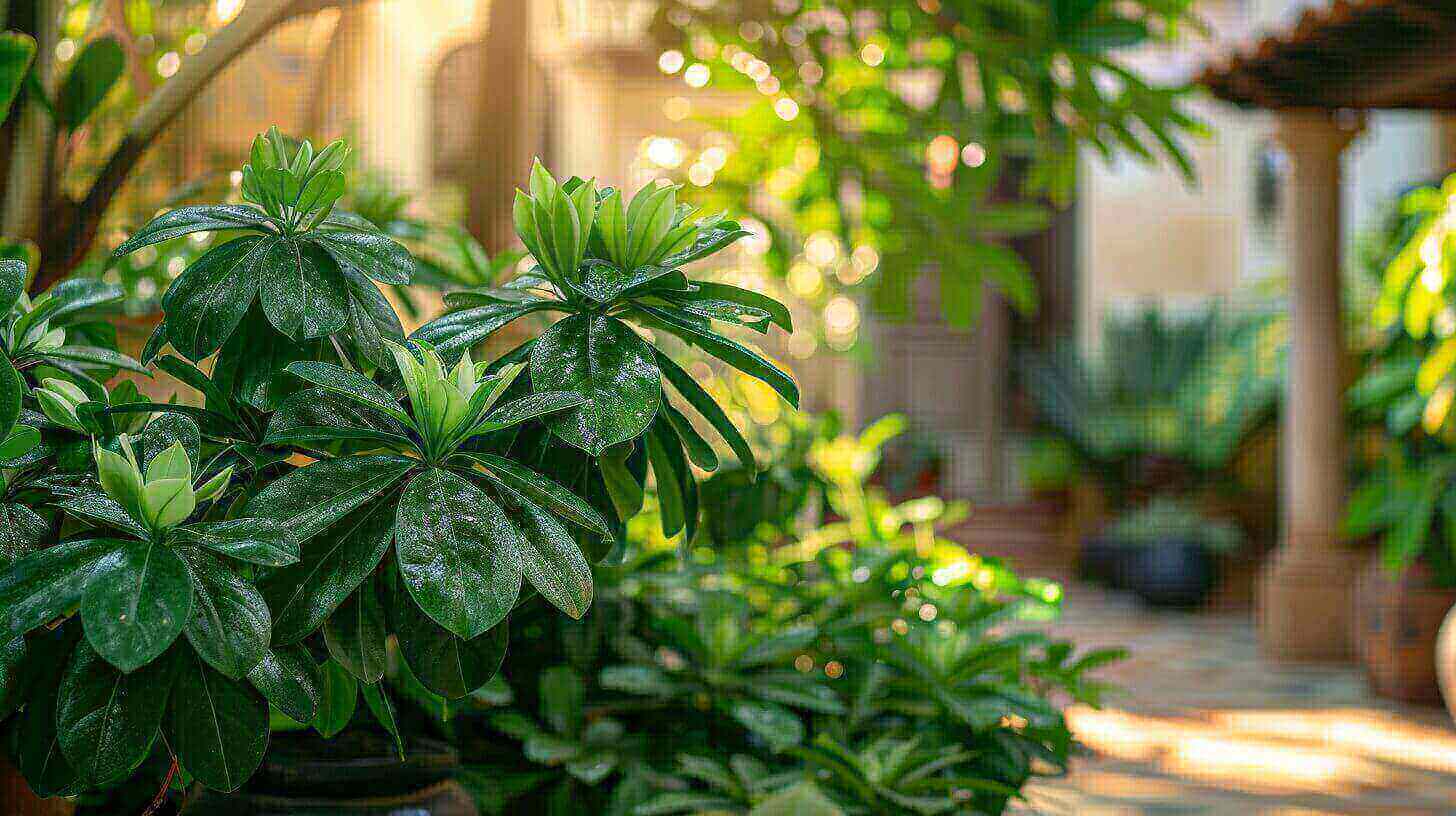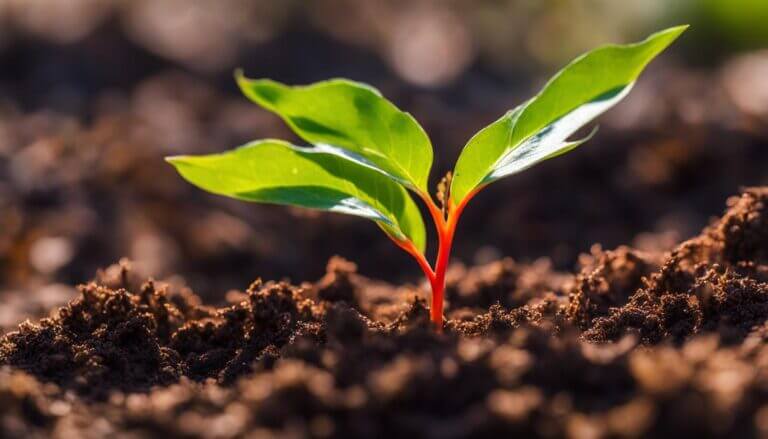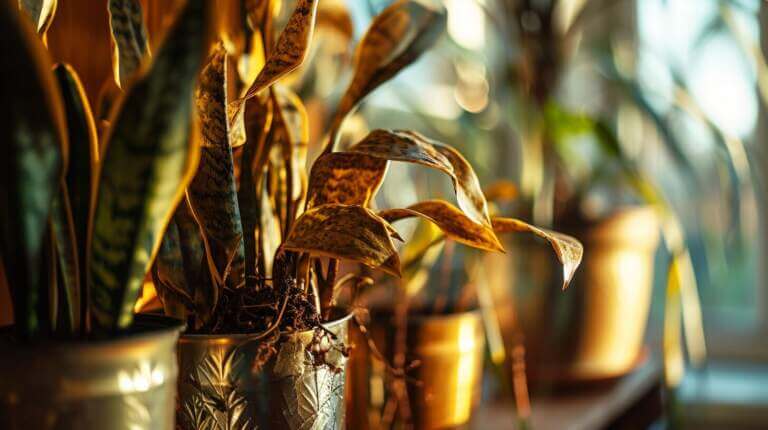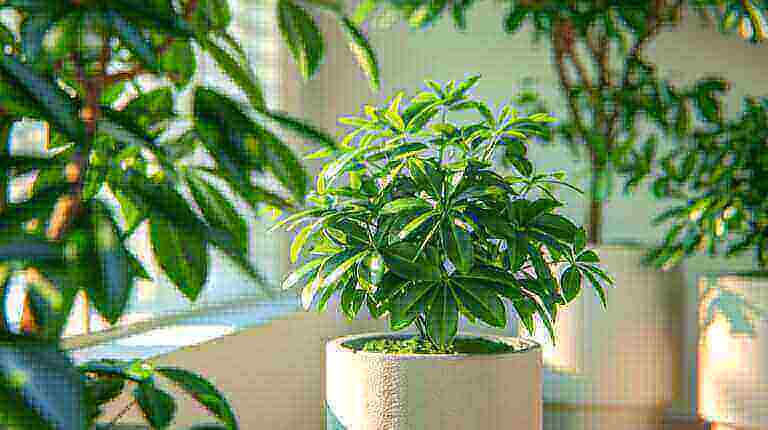How To Grow And Care For Schefflera Plant Or Umbrella Tree Outdoors In Warm Climates
Growing schefflera outdoors in warm climates can bring a touch of tropical beauty to your garden. These lush, vibrant plants thrive in locations like southern California, Florida, and Phoenix, where the high humidity supports their growth. While not reliably hardy in USDA zones 10 and 11, schefflera plants can still be grown as container plants and moved indoors during colder temperatures. With the right care and attention, you can enjoy the beauty of schefflera in your outdoor space.
When it comes to outdoor schefflera care, there are a few key factors to consider. Providing partial to full shade is essential, as direct sunlight can scorch the leaves. Incorporating well-rotted compost or organic amendments into the soil will help mimic the nutrient-rich conditions of the plant’s native range. Regular watering is important to keep the soil evenly moist, but be careful not to overwater, as this can lead to root rot. Finally, supporting larger plants with stakes or trellises can prevent damage to driveways or foundations.
Schefflera plants are known for their large, glossy leaves and can reach impressive heights. To maintain their height and fullness, pruning becomes necessary. Regular pruning helps control the growth and encourages bushier foliage. Additionally, schefflera plants can be propagated by taking stem cuttings during the summer months. By following these guidelines and addressing any issues promptly, you can ensure the continued growth and health of your outdoor schefflera plants.
Key Takeaways:
- Choose a location with partial to full shade for outdoor schefflera plants.
- Provide well-rotted compost or organic amendments for nutrient-rich soil.
- Water regularly, keeping the soil moist but not waterlogged.
- Support larger plants to prevent damage.
- Prune schefflera plants to maintain their height and fullness.
Choosing the Right Location and Soil for Outdoor Schefflera Plants
When it comes to growing schefflera plants outdoors, selecting the right location and soil is crucial for their success. The first step is to choose a spot that provides the ideal amount of light for your climate. In warmer areas, schefflera plants can tolerate full sun, while in hotter regions, partial shade is recommended to prevent leaf burn. Pay attention to the specific needs of your schefflera variety and adjust the light exposure accordingly.
Equally important is the soil in which your schefflera plants will be planted. These tropical plants thrive in well-drained soil that mimics their native habitat. To achieve this, incorporate well-rotted compost or organic amendments into the soil. This will not only enrich the soil with nutrients but also improve its drainage capabilities, preventing the risk of root rot. If your soil is heavy and tends to retain water, adding sand or perlite can help improve drainage.
Table: Ideal Light and Soil Conditions for Outdoor Schefflera Plants
| Light Exposure | Ideal Soil Conditions |
|---|---|
| Full sun | Well-drained soil with organic amendments |
| Partial shade | Well-drained soil with organic amendments |
Remember that schefflera plants are native to tropical regions, so they thrive in high humidity. If you live in a dry climate, consider placing your schefflera plants in a microclimate that provides increased humidity, such as near a pond or fountain. With the right location and soil conditions, your schefflera plants will have a solid foundation to grow and flourish in your outdoor garden.
Next, we will explore the proper care routine for outdoor schefflera plants, including watering, pest control, pruning, and support. These essential steps will ensure the health and vitality of your schefflera plants, allowing them to thrive in their outdoor environment.
Proper Care for Outdoor Schefflera Plants
Proper care is essential for the health and vitality of outdoor schefflera plants. By following a few key practices, you can ensure that your plants thrive and continue to beautify your garden. Here are some important aspects of outdoor schefflera care to keep in mind:
Watering Schefflera Plants
Watering is crucial for the well-being of schefflera plants. While they prefer consistently moist soil, it’s important to avoid overwatering, as this can lead to root rot. Check the moisture level of the soil regularly and water when the top inch feels dry. Be sure to provide enough water to thoroughly saturate the root zone. However, ensure that the soil is well-draining to prevent waterlogging. Remember, outdoor schefflera plants may require more frequent watering during hot and dry spells.
Pest Control
Outdoor schefflera plants can be susceptible to common pests such as mealybugs, scale insects, aphids, and spider mites. Regularly inspect your plants for signs of infestation, such as white cottony masses or small crawling insects. If you notice any pests, take appropriate measures for pest control. This may include using insecticidal soap or other organic insecticides. Treating the infestation early can help prevent further damage to your plants.
Pruning Schefflera Umbrella Plant
Pruning schefflera plants is important to maintain their shape and encourage healthy growth. Remove any dead, damaged, or diseased branches with clean pruning shears. Additionally, you may want to prune back any leggy or overgrown growth to promote bushier, more compact growth. Always disinfect your pruning tools before and after each use to prevent the spread of disease.
| Care Guidelines | Details |
|---|---|
| Watering | Consistently moist soil, avoid overwatering |
| Pest Control | Regular inspection, use organic insecticides |
| Pruning | Remove dead/damaged branches, promote bushier growth |
Support for Schefflera Plants
As schefflera plants can grow quite large, providing support is important to prevent damage to driveways, foundations, or nearby structures. Use stakes or trellises to support the main stem of the plant and help it maintain an upright position. Regularly check the supports to ensure they are secure and in good condition.
With proper care and attention, your outdoor schefflera plants will flourish, adding beauty and a tropical touch to your garden. By following these guidelines, you can enjoy the vibrant foliage and lush growth of schefflera plants throughout the year.
Propagating and Repotting Schefflera Umbrella Tree Plants
When it comes to propagating and repotting schefflera plants, there are a few key steps and considerations to keep in mind. Propagating schefflera can be done through stem cuttings taken during the summer months. To do this, simply cut off a 6-inch section of the stem, remove any lower leaves, and place the cutting in a small container filled with moist potting mix. Keep the soil consistently moist until roots develop, and then you can transplant the new plant into a larger pot or your garden.
As for repotting schefflera plants, it’s important to do this annually or as needed. Choose a well-draining potting mix and ensure that the new pot has good drainage holes. Gently remove the plant from its current pot, being careful not to damage the roots. Place the schefflera into the new pot and fill in with fresh potting mix, pressing it down gently to remove any air pockets. Water the newly repotted plant thoroughly and place it in a location that receives partial shade.
Table: Propagation and Repotting Steps
| Propagation | Repotting |
|---|---|
| 1. Take stem cuttings during summer months. | 1. Repot annually or as needed. |
| 2. Remove lower leaves from the cutting. | 2. Choose a well-draining potting mix. |
| 3. Place the cutting in moist potting mix. | 3. Ensure new pot has good drainage holes. |
| 4. Keep soil consistently moist until roots develop. | 4. Gently remove plant from current pot. |
| 5. Place schefflera into new pot and fill with fresh potting mix. | |
| 6. Water thoroughly and place in partial shade. |
Proper propagation and repotting techniques will ensure the continued growth and health of your schefflera plants, allowing them to thrive in your outdoor space. Remember to provide adequate care, regular watering, and appropriate fertilization to promote healthy foliage and growth. By following these steps and giving your schefflera plants the attention they need, you can enjoy the beauty of these tropical plants for years to come.
Fertilizing and Pruning Schefflera Plants
Proper fertilization and pruning are essential for maintaining the health and appearance of outdoor schefflera plants. Fertilizing schefflera regularly will provide the necessary nutrients for robust growth. Additionally, pruning helps to shape the plant and encourage new growth, resulting in a fuller and more attractive appearance.
Fertilizing Schefflera
When it comes to fertilizing schefflera plants, regular feeding is key. Use a liquid fertilizer formulated for houseplants, following the instructions on the label. Alternatively, you can opt for slow-release pellets that gradually release nutrients over time. Apply the fertilizer twice a week during the growing season to ensure a steady supply of essential nutrients.
While fertilizing schefflera, it is important to avoid overfeeding, as this can lead to nutrient burn and damage to the plant. Always follow the recommended dosage provided by the fertilizer manufacturer. Additionally, make sure to water the plant thoroughly after fertilizing to prevent the roots from being burned by concentrated fertilizer.
Pruning Schefflera
Pruning schefflera plants is necessary to maintain their height, shape, and overall appearance. Regular pruning also helps to remove any dead or damaged growth, promoting the growth of new and healthy branches.
When pruning schefflera, start by cutting off the top of the plant to encourage new growth and maintain its desired height. You can also pinch off the growing tips to promote bushier growth and prevent the plant from becoming leggy.
Tip: Always wear gloves when pruning schefflera plants to avoid contact with the sap, which can cause a rash in some individuals.
Pruning schefflera can be done throughout the year, but it is best to avoid heavy pruning during the winter months when the plant is in its dormant phase. Instead, focus on light pruning to remove any dead or diseased branches.
By properly fertilizing and pruning schefflera plants, you can ensure they remain healthy, vibrant, and visually appealing. Regular feeding with the right fertilizer and strategic pruning will help your outdoor schefflera thrive and enhance the beauty of your garden.
Common Problems and Solutions for Outdoor Schefflera Plants
Outdoor schefflera plants, like any other plants, can encounter a variety of issues that may affect their health and growth. Understanding and addressing these problems promptly is crucial to ensuring the longevity and vitality of your schefflera plants. Here are some common problems and their corresponding solutions:
Common Plant Diseases
Schefflera plants are susceptible to bacterial leaf spot and alternaria leaf spot. These diseases can cause dark, water-soaked spots on the leaves, which can eventually lead to leaf drop if left untreated. To prevent these diseases, avoid overhead watering and water the plants in the evening. If necessary, apply a copper fungicide according to the product instructions.
Pest Control
Aphids, mealybugs, scale insects, and spider mites are common pests that can infest outdoor schefflera plants. These pests can cause damage to the leaves and weaken the overall health of the plant. To control these infestations, use insecticidal soap or other appropriate insecticides. Regularly inspect your plants for any signs of pests and take immediate action to prevent further damage.
Schefflera Care Tips
Proper care plays a vital role in keeping your outdoor schefflera plants healthy. Here are a few tips to ensure their well-being:
- Monitor watering: Overwatering can cause the leaves to turn yellow. Adjust your watering schedule accordingly, allowing the soil to dry out slightly between waterings.
- Provide adequate light and shade: Schefflera plants thrive in partial to full shade. Avoid exposing them to direct sunlight for extended periods, as it can lead to leaf burn.
- Regularly fertilize: Feed your schefflera plants with a suitable liquid fertilizer or slow-release pellets during the growing season. Follow the product instructions for proper dosage and frequency.
- Prune when necessary: Trim off any overgrown or leggy growth to maintain the plant’s shape and encourage bushier growth. Always wear gloves when pruning to avoid contact with the sap, which can cause skin irritation in some individuals.
By addressing these common problems and following these care tips, you can ensure that your outdoor schefflera plants thrive and continue to enhance the beauty of your garden. Remember to be attentive to their needs and take prompt action to maintain their health and vitality.
| Problem | Solution |
|---|---|
| Bacterial Leaf Spot | Avoid overhead watering and apply copper fungicide if necessary |
| Alternaria Leaf Spot | Avoid overhead watering and apply copper fungicide if necessary |
| Aphid Infestation | Use insecticidal soap or appropriate insecticides for control |
| Mealybug Infestation | Use insecticidal soap or appropriate insecticides for control |
| Scale Insect Infestation | Use insecticidal soap or appropriate insecticides for control |
| Spider Mite Infestation | Use insecticidal soap or appropriate insecticides for control |
FAQ
Can schefflera plants be grown outdoors in warm climates?
Yes, schefflera plants can be grown outdoors in warm climates. However, they are not reliably hardy in USDA zones 10 and 11, so they may need to be grown as container plants and moved indoors during colder temperatures.
What is the ideal location and soil for outdoor schefflera plants?
Outdoor schefflera plants prefer partial to full shade, well-drained soil, and nutrient-rich conditions. Incorporate well-rotted compost or organic amendments into the soil to mimic their native range.
How should I care for outdoor schefflera plants?
Outdoor schefflera plants require regular watering, pest control measures, pruning to maintain height and fullness, and support for larger plants to prevent damage. They also benefit from regular fertilization to support their growth.
How can I propagate and repot schefflera plants?
You can propagate schefflera plants by taking stem cuttings during the summer and placing them in moist potting mix until roots develop. Mature schefflera plants should be repotted annually or as needed using a well-draining potting mix.
How should I fertilize and prune schefflera plants?
Outdoor schefflera plants can be fertilized with a liquid fertilizer for houseplants or slow-release pellets according to label directions. Pruning schefflera plants is important to maintain their height and fullness. Always wear gloves when pruning to avoid contact with the sap.
What are common problems and solutions for outdoor schefflera plants?
Outdoor schefflera plants may face issues such as bacterial leaf spot, alternaria leaf spot, and pest infestations. Avoid overhead watering, water in the evening, and apply copper fungicide if necessary. Treat pests with insecticidal soap. Yellow leaves may be a sign of overwatering, so adjust your watering schedule accordingly.
How can I successfully grow schefflera outdoors?
By following the guidelines for choosing the right location and soil, providing proper care, fertilization, and pest control, you can successfully grow schefflera outdoors. Addressing any problems promptly and giving your plants the attention they need will help them thrive in your outdoor space.







